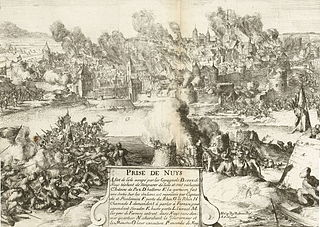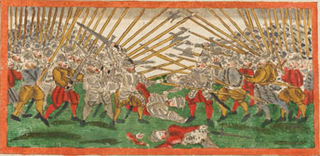
The Battle of Zutphen was fought on 22 September 1586, near the village of Warnsveld and the town of Zutphen, the Netherlands, during the Eighty Years' War. It was fought between the forces of the United Provinces of the Netherlands, aided by the English, against the Spanish. In 1585, England signed the Treaty of Nonsuch with the States-General of the Netherlands and formally entered the war against Spain. Robert Dudley, Earl of Leicester, was appointed as the Governor-General of the Netherlands and sent there in command of an English army to support the Dutch rebels. When Alessandro Farnese, Duke of Parma and commander of the Spanish Army of Flanders, besieged the town of Rheinberg during the Cologne War, Leicester, in turn, besieged the town of Zutphen, in the province of Gelderland and on the eastern bank of the river IJssel.
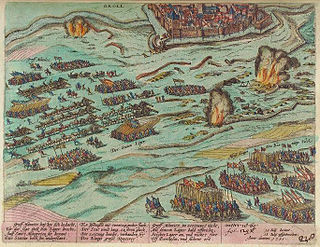
The siege of Grol or Groenlo in 1595 was a siege of Groenlo by States forces under Maurice of Nassau during the Eighty Years' War in an attempt to capture it from the Spanish Empire. It lasted from 14 to 24 July 1595, ending with the arrival of a Spanish relief force under Cristóbal de Mondragón and Maurice's retreat. Two years later, in 1597, Maurice returned to carry out another siege of Groenlo. Both these sieges formed part of what would later be called the Ten Glorious Years.
Count Jan van Stirum was a Dutch figure of the Eighty Years' War. Originally a canon in Cologne, he later moved to serve in the military of the Spanish Empire, rising through its ranks to become governor of Grol from 1592 to 1597.

The siege of Groenlo was a siege of Groenlo during the Eighty Years' War and the Anglo–Spanish War by a Dutch and English army led by Maurice of Nassau after it had followed an unsuccessful siege by Maurice in 1595.

Maarten (Martin) Schenck van Nydeggen, was a noted military commander in the Netherlands.
Hermann Friedrich Cloedt was commander of the garrison at Neuss (Nuys), near Duisburg, in July 1586, when the city was destroyed by the Duke of Parma's Army of Flanders. He died in the defense of Neuss.

The Battle of Werl occurred between 3–8 March 1586, during a month-long campaign in the Duchy of Westphalia by mercenaries fighting for the Protestant (Calvinist) Archbishop-Prince Elector of Cologne, Gebhard Truchsess von Waldburg.

The siege of Rheinberg 1586–1590, also known as the capture of Rheinberg of 1590, took place at the strategic Cologne enclave of Rheinberg, one of the principal crossing-points over the Rhine on the stretch between the Electorate of Cologne and the Dutch border, between 13 August 1586 and 3 February 1590, during the Eighty Years' War, the Cologne War, and the Anglo-Spanish War (1585–1604). After an initial siege in 1586, and a long blocking by the Spanish forces until September 1589, Don Alexander Farnese, Duke of Parma (Spanish: Alejandro Farnesio), commander-in-chief of the Spanish army, sent a substantial force, under Peter Ernst, Count of Mansfeld, to besiege Rheinberg. Despite the efforts by Maarten Schenck van Nydeggen, and Sir Francis Vere, to relieve the fortress city, the Protestant garrison finally surrendered to the Spaniards on 3 February 1590.
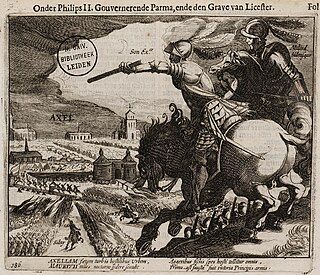
The Capture of Axel was a military event during the Dutch Revolt and the Anglo–Spanish War in which the town of Axel, defended by the Spanish, was captured by an Anglo-Dutch force led by Sir Philip Sidney, with the garrison being put to the sword. It was also the first feat of Maurice of Nassau.

The capture of Enschede took place during the Eighty Years' War and the Anglo–Spanish War on 18 and 19 October 1597. A Dutch and English army led by Maurice of Orange took the city after a very short siege and threatening that they would destroy the city. The siege was part of Maurice's campaign of 1597, a successful offensive against the Spaniards during what the Dutch call the Ten Glory Years.

The siege of Oldenzaal was a short siege that took place during the Eighty Years' War and the Anglo–Spanish War by a Dutch and English army led by Maurice of Orange of the city of Oldenzaal from 20 to 23 October 1597. The city surrendered to the overwhelming Dutch and English force. The siege was part of Maurice's campaign of 1597 known as the Ten Glory Years, his highly successful offensive against the Spaniards.

The siege of Meurs took place between 29 August to 3 September 1597 during the Eighty Years' War and the Anglo–Spanish War. The Spanish occupied city of Moers under Governor Andrés de Miranda was besieged by Dutch and English troops under the command of Prince Maurice of Orange. The siege ended with the capitulation and the withdrawal of the Spanish garrison. The siege was part of Maurice's campaign of 1597 known as the Ten Glory Years, his highly successful offensive against the Spaniards.

The siege of Rheinberg took place from the 9 to 19 August 1597 during the Eighty Years' War and the Anglo–Spanish War by a Dutch and English army led by Maurice of Orange. The siege ended with the capitulation and the withdrawal of the Spanish after much unrest in the garrison. The liberation of the city of Rheinberg was the commencement of Maurice's campaign of 1597, a successful offensive against the Spaniards during the period known as the Ten Glory Years.

The Capture of Ootmarsum in 1597 was a short siege, that took place during the Eighty Years' War and the Anglo–Spanish War by a Dutch and English army led by Count Van Duivenvoorde while Maurice of Nassau was besieging Oldenzaal. The siege lasted from 19 to 21 October, where the Spanish garrison of Ootmarsum under the governor, Otto Van Den Sande, surrendered and was then occupied by the besiegers. The siege was part of Maurice's successful offensive against the Spaniards during the same year.

The siege of Grave, also known as the capture of Grave of 1586, took place from mid-February to 7 June 1586 at Grave, Duchy of Brabant, Low Countries, between the Spanish army led by Governor-General Don Alexander Farnese, Prince of Parma, and the Dutch-States and English forces under Baron Peter van Hemart, Governor of Grave, during the Eighty Years' War and the Anglo-Spanish War (1585–1604).

The siege of Huy of 1595, also known as the assault of Huy, took place between 7 and 20 March 1595, at Huy, Archbishopric of Liège, Low Countries, as part of the Eighty Years' War and the Anglo-Spanish War (1585–1604). It concluded in a Spanish victory.
The Mutiny of Hoogstraten was the longest mutiny by soldiers of the Army of Flanders during the Eighty Years' War. Frederick Van den Berg's attempt to end the mutiny by force, with a siege to recapture the town, ended in defeat at the hands of an Anglo-Dutch army under of Maurice of Nassau. After a period of nearly three years the mutineers were able either to join Maurice's army or rejoin the Spanish army after a pardon had been ratified.
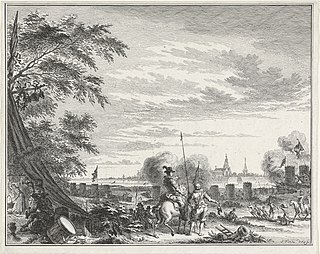
The siege of Grave was a siege that took place between 18 July and 20 September 1602, as part of the Eighty Years' War and the Anglo–Spanish War. The Spanish-held city of Grave was besieged by a Dutch and English army led by Maurice of Orange and Francis Vere respectively. After a siege of nearly two months the city surrendered when a Spanish relief army under Francisco de Mendoza was defeated just outside the city by the besiegers. The defeat was severe enough to cause a major mutiny in the Spanish army.

The siege of Nijmegen was a military engagement during the Eighty Years' War and the Anglo–Spanish War which took place from 17 to 21 October 1591. The Spanish garrison in Nijmegen was besieged by a Dutch and English force under Maurice of Nassau and Francis Vere respectively and surrendered soon.





